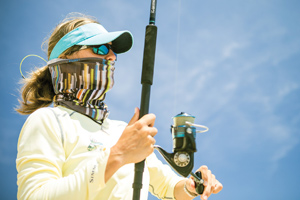While many boats are stowed away now that we’re in the middle of winter, many others are on the saltwater, rivers, and lakes of our region. As a bit of a departure from the usual what to fish for and where, I’ll touch on a more serious aspect of angling this month: safety.
Many fisherfolk say they live to fish. As we all would like to live and fish for a good long time, getting serious about safety on the water should be a priority. Due to my profession, I often pilot boats singlehanded, so the subject of staying safe is on my mind a lot. Let me give some tips I’ve learned on how to stay afloat and in the boat while chasing fish. I won’t be able to cover all aspects of safety this month, so we’ll cover other related topics next month as well.
The first thing I do before a trip on the water is to check the weather forecast. I don’t mean checking it the morning before going out. I’ll have my eye on the forecast every day. I use the local NOAA marine forecasts as well as Sailflow app. Sometimes in weather forecasting, it’s not if, but when a blow is coming. Sometimes NOAA will see it first and sometimes Sailflow will. If both sites are calling for wind the day before, then it’s very likely going to happen. Sailflow usually has more specific data as to when and where the wind event will take place. It could be blowing hard out in the straits, but not that badly in the interior. Or, rarely, the opposite. Wind direction is key too.
Will you be fishing in waters that are blocked by a landmass from the gusts? Or is your planned route looking right down the barrel of a loaded gun?
Tides can make a big difference in wave height and sea state too. A big ebb tide and a south wind in a place like Rosario Strait can make for a very bumpy ride. In the ocean, swell height and duration as well as wind speed make a huge difference.
Many seasoned saltwater anglers have a formula combining these three that means a “no go” for the day. Many times, this will be decided on the size and seaworthiness of the vessel to be used as well. Sometimes the bar crossing will be closed and the decision is made for you. You’ll often hear the phrases “if it’s blowin’, we’re goin’,” or “no guts, no glory.” I’ve used these myself before heading out to fish in a big money derby.
There’s also a phrase that says, “discretion is the better part of valor.” I’ve used that one too. And, trust me, there are times that it’s rough enough that fishing is no fun and not very productive either. Trolling is a chore in the wind, and it’s hard to spot tuna in big waves. This time of year, sitting in front of a warm fire knowing your boat is storm-tied at the dock or strapped safely to the trailer can be a pretty contented feeling.
When I’m out on the water, especially by myself, I always try to have at least an inflatable PFD on when leaving the dock. Make sure all the crew wears one too. Inflatables don’t restrict movement, and after wearing one for a bit, you don’t even know it’s on. Make sure you know how to use yours and that it’s recharged or replaced when needed. In the winter, I like to wear the Mustang brand float coats, too. The Coast Guard likes them as well. I’ve gotten the thumbs up from them when they’ve checked and I’ve had mine on.
Everyone on the boat should know where extra lifejackets, throwables, life rafts, and/or survival suits are and how to use them. Things happen quickly out there. Sometimes even in good weather.
I’ve often wondered, especially after passing the half-century mark in age, that if I fall out of this boat while trolling, would I be able to swim back to it and get back in? The answer is probably no. We have some frigid water temps in the Northwest and going over into cold water will knock the air right out of your lungs. Add tidal currents and vessel speed underway and the odds of survival are pretty slim, especially in the winter with fewer vessels around that may see you.
Some good remote engine shut-off systems are available now, and I would strongly suggest investing in one. A tethered kill switch is not always practical while actively fishing and moving around the boat. However, my main mantra to the crew while fishing is “STAY IN THE BOAT!” Actively fishing requires bending over the gunwales at times. Keep your feet on the deck. Remember the game of jumping from chair to coffee table to couch as kids, pretending the carpet is hot lava? Think of it that way, except this ain’t no game and that water ain’t hot.
We’ve got the Friday Harbor Salmon Classic, part of the NMTA derby series, this month. Whether you’re fishing the tournament or just out trying to catch some seafood, think about making it back unscathed. Common sense and good judgement goes a long way. Until next month, stay safe and let’s go get some!



